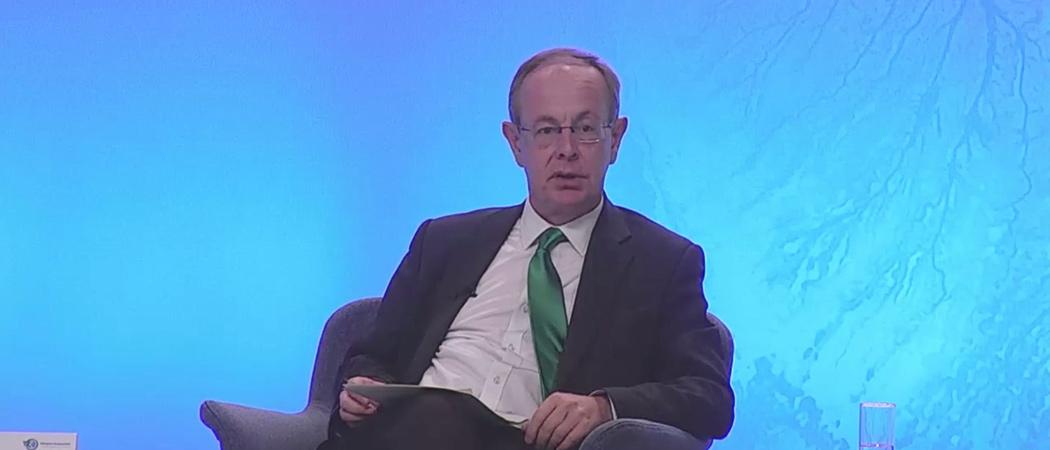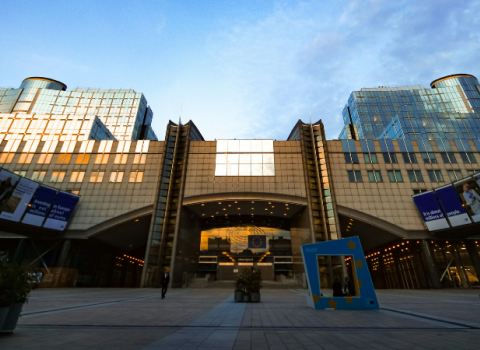Mission Innovation aims to avoid duplication of R&D and get green tech to market sooner. Its targets will provide support for the US/China pledge to accelerate low-carbon transition and climate technology innovation

Patrick Child, chair of the steering committee, deputy director general for environment at the European Commission. Photo: Twitter @childp_child
An international body of the world’s major research powers has turned its attention to coordinating the globe’s green innovation efforts, just as the US and China made a surprise declaration at the COP26 climate conference that they would work together on clean technology.
Mission Innovation, set up in 2015 by Barack Obama and other world leaders, has this year pivoted to a new strategy that sees the countries involved work together on specific climate missions, for example, sucking 100 million metric tons of carbon dioxide out of the atmosphere annually by 2030, some of which were newly unveiled at COP26.
Despite a rivalry over technological leadership between the US and China, both are members of Mission Innovation, along with 21 other countries. Collectively the body claims to represent over 90 per cent of the world’s public investment in clean energy innovation.
“You might advance more quickly…if we work more closely together,” said Patrick Child, chair of the steering committee, and deputy director general for environment at the European Commission.
“If we know that there’s a certain organisation in Australia that’s looking into a certain aspect of clean hydrogen, then we in Europe might decide to look into a different aspect, rather than doing the same again,” he told Science|Business.
The body’s new mission chimes with a tone of collaboration set by an unexpected joint US-China statement as the conference nears its close.
The geopolitical rivals will work “individually, jointly, and with other countries during this decisive decade” on issues including “accelerating the green and low-carbon transition and climate technology innovation,” the statement says.
This follows disappointment that Chinese president Xi Jinping did not attend the conference in person, and that China was notably absent from a number of initiatives launched at the conference, including a pledge to cut methane emissions.
The statement also pledges cooperation on the “deployment and application” of technologies including carbon capture and storage, and direct air capture.
In addition, the US and China said they would “foster joint research into methane emission reduction challenges and solutions”.
A stretch
Originally launched alongside the 2015 Paris Agreement, the 20 governments that signed up to Mission Innovation pledged to double their respective clean energy research and development investment over five years.
For a number of members this was “quite a stretch”, said Child, but to a “very large extent many partners achieved that doubling.”
According to a progress report last year, spending after four years had increased by 60 per cent – a sizable increase, but still well short of the promised doubling over five years.
This year, the organisation has taken a different tack. There are no more specific R&D spending commitments, but in their place are missions with specific goals, each led by a handful of member countries.
So far, there are seven missions: zero-emissions shipping; clean hydrogen; integrating green power into electricity grids; removing carbon dioxide from the atmosphere; creating demonstration projects for net-zero cities; green refurbishment of steel, cement, and chemicals plants; and replacing fossil fuels with biofuels.
The latter four were launched at COP26, and although some of them are still to have their missions defined, Child said they will have to boast concrete targets.
“In order for a mission to be accepted by the community, it has to have real substance. It can’t just be, it would be nice to work together,” he said. The hydrogen goal, for example, is to reduce the cost of the gas to $2 a kilogram by 2030.
But these missions do not generally come with significant amounts of new money behind them.
“Of course, these are topics that members of Mission Innovation are working on through their national programmes,” acknowledged Child.
The carbon removal mission, for example, commits the countries leading it, the UK, Saudi Arabia, Canada and Norway, to spend either $5 million a year over the next five years, or demonstrate “prior investments…that can be leveraged to support Mission objectives”.
“Mission Innovation is not about creating a huge pot of money and entrusting it to an international organisation and then deciding together how that money is spent. Nor is it a classical forum for information exchange,” said Child. “It’s a sort of hybrid between those two things.”
Innovation pathway
A key focus is making sure countries know what each other are working on so they can join up their research efforts. One of the next steps will be for each to submit an “innovation pathway” describing their clean energy research plans over the next 4-5 years, creating “a sort of basis of information for us to better identify areas of collaboration in the future,” he said.
The EU already coordinates member state energy research efforts through its Strategic Energy Technology Plan. This gave the Commission “a lot of experience and inspiration which we were able to share with the wider community” when it joined Mission Innovation, said Child.
Yet getting geopolitical rivals like the US and China to coordinate their research efforts may be a taller order than among EU member states.
“Of course there is a competitive dimension to it, and there are unsurprising nuances in the priorities of different countries,” said Child. Norway, for example, is particularly enthusiastic about so-called blue hydrogen, generated from natural gas of which it has plentiful reserves, but capturing the carbon dioxide. Others are less keen. “You see differences,” he said.
In its second, mission-focused phase, the organisation has kept the vast majority of its original members on board, and includes almost every major research power, including the US, China, India, the EU, UK, Japan, South Korea, France, Germany, Italy, Brazil, Canada, Australia, Norway and Saudi Arabia. Russia is conspicuously absent.
Only Indonesia decided to drop out, said Child, and Mexico is now an “observer” country. “We don’t want to have passengers, basically…we want everyone bringing something to the party,” he said.




 A unique international forum for public research organisations and companies to connect their external engagement with strategic interests around their R&D system.
A unique international forum for public research organisations and companies to connect their external engagement with strategic interests around their R&D system.